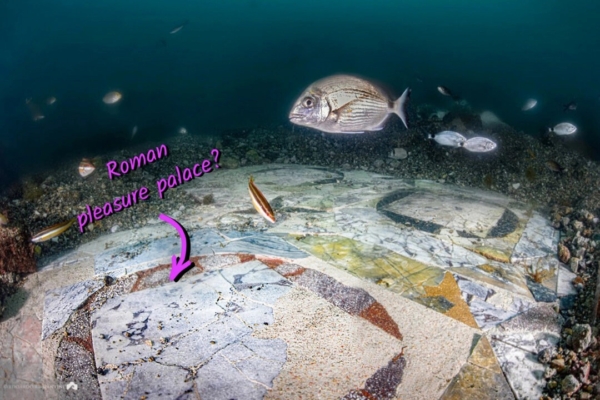Did they know? The lavish Romans living in the opulent villas of Baiae, indulging in extravagance on marble floors, did they know that their magnificent homes would be submerged beneath the Gulf of Pozzuoli due to a volcanic eruption?
They might not have known.
Today, we know this because the exquisite marble floors from Roman times have emerged from the seabed rubble, now forming a large underwater archaeological site near the southern coast of Italy, known as the Baiae Underwater Archaeological Park. Here, archaeologists have discovered well-preserved mosaics and other ancient ruins.
Within an area of approximately 2,700 square feet in Baiae, underwater archaeologists have observed a technique called “opus sectile” inlaid marble flooring. According to Phlegraean Fields Archaeological Park, this style is typical of the 3rd to 5th centuries AD and includes a basilica with a courtyard—a typical Roman floor plan.
The floor is arranged in a grid pattern, about 20 squares wide and 30 squares long, totaling around 600 squares. Each rhombus measures approximately 24 x 24 inches (60 cm x 60 cm), or two Roman feet. Despite being scattered, the clear pattern showcases various colored tiles. Each large square contains a different-toned small square, inset with an octagon. Within each octagon is another smaller light-toned circle. At the corners of each large square, the intersections form a quatrefoil.
From the varying thickness of the slabs, researchers believe they are recycled “second-hand” fragments from other buildings, creating a “highly complex geometric design” of thousands of intricate shapes. Researchers note the varied quality and color of the marble.
Following a storm in 2012, a small portion of the floor was first discovered, but direct restoration work did not begin until May 2024 due to various challenges. The original fragments of the floor and the seabed action caused the inlaid panels to separate from the seafloor.
“This floor, in small parts, has been known for a long time, but the ruins are very scattered, incomplete, hindering restoration work,” Enrico Gallocchio from Phlegraean Fields Archaeological Park told Newsweek. “Through extensive restoration work, we can start addressing the most exposed parts, those less covered by sand on the seabed. So, it’s not truly a new discovery, but understanding its design is a discovery because we didn’t know its geometric shape.”
“This discovery tells us what happened in Baiae just before it sank,” Gallocchio said.
Dubbed the “Las Vegas of Ancient Rome,” Baiae was a resort port where people indulged in leisure, moral values thrown to the wind. Stoic philosopher Seneca described it as, “The people wandering, stupefied by drink, on the seashore, the mad revels aboard the fleets of ships, the shouting and singing on the lake, all the other ways of indulgence… not only transgressed laws but flaunted their evil deeds overseas.” He lamented, “Why must I witness all this?”
In Greek, “Phlegraean Fields” translates to “burning lands.” Located within the volcanic caldera formed by the Gulf of Naples, near Baiae, they are part of the Campanian volcanic arc, a hotspot for magma activity.
Perhaps the Romans of that era knew this. But they may not have foreseen the eruption of Mount Vesuvius in 79 AD over Pompeii and the gradual flooding caused by volcanic activity. Magma pushed to the surface in a process called bradyseism, gradually submerged the leisurely Roman resort of Baiae. Other submerged residential ruins and mosaic floors have also been found in Baiae.
Researchers found from the villa ruins that it either collapsed shortly before submerging or immediately after. They noted that plaster and construction debris from the collapsed walls fell onto the marble floors, supporting this conclusion.
Divers are working to restore the fragments of the slabs. They are using special mortar that matches the colors of the marble floor. Fragments considered too scattered or difficult to reintegrate are being collected in boxes and brought to the surface for desalination with fresh water.
“With these elements, we are trying to reassemble one or more square modules for future integration and display in the museum,” park officials said. The marble floor is now covered, awaiting further restoration in September, though divers have ensured to take plenty of photographs beforehand.

